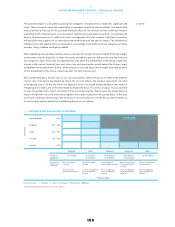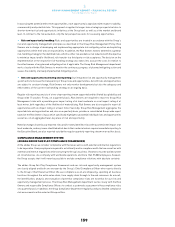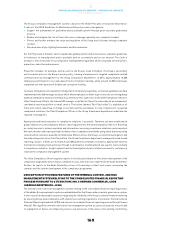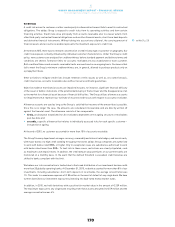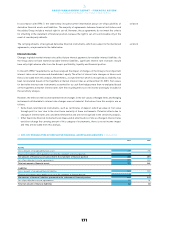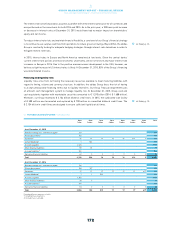Reebok 2015 Annual Report Download - page 167
Download and view the complete annual report
Please find page 167 of the 2015 Reebok annual report below. You can navigate through the pages in the report by either clicking on the pages listed below, or by using the keyword search tool below to find specific information within the annual report.
163
3
GROUP MANAGEMENT REPORT – FINANCIAL REVIEW
Risk and Opportunity Report – Illustration of Material Risks
STRATEGIC RISKS
Risks related to organisational structure and change
Operating in a dynamic and fast-moving competitive environment, the Group needs to cope with constantly
changing requirements in respect of the workforce (e.g. regarding adaptability, learning, skillsets, mobility,
diversity) and workplace (e.g. regarding flexibility and space management). Therefore, organisational
flexibility and the ability to adapt quickly to new competitive circumstances are critical to remain successful.
A complex organisational structure and unclear roles and responsibilities across the Group can lead
to delayed or sub-optimal decision-making, inefficient and ineffective processes and, consequently,
higher costs. Improper planning and execution of reorganisation and transformation initiatives may
reduce employee engagement, cause business disruption and result in higher costs. A high frequency
in organisational changes could cause fatigue among the workforce and lead to reduced efficiency and
productivity. Inadequate change management could lead to non-acceptance of changes by the workforce,
lower employee engagement and inefficiencies. The HR function plays a key role in driving effective change
management.
We mitigate these risks through continuous, open and transparent communication with our employees.
Our Executive Board members as well as the senior management team across the Group hold regular
‘town hall’ meetings to update employees on organisational changes and openly explain the reasons for
change. To adequately manage change and to ensure clarity about roles and responsibilities throughout the
organisation, we also utilise internal and external experts in project management, change management and
communication, who actively educate and engage the workforce to embrace and support new organisational
structures and processes. To increase flexibility and adaptability of the workforce and workplace and thereby
reduce risks related to organisational change, we have kicked off the implementation of various mitigating
measures such as strategic workforce planning, tailored on-the-job learning programmes and development
plans for our employees, as well as the future workplace concept, which was introduced as part of a pilot
programme at the Group’s headquarters in Herzogenaurach, Germany, in 2015.
Risks related to distribution strategy
The inability to appropriately influence in which channels the Group’s products are sold constitutes a
continuous risk. Grey market activity or parallel imports could negatively affect our own sales performance
and the image of our Group brands. Furthermore, changes to segmentation and channel strategies could
lead to inadequate utilisation of our multiple distribution channels as well as strong retaliation from our
customers. An unbalanced portfolio of own-retail stores (e.g. overexposure to certain markets or store
formats) or inappropriate store locations may result in worse-than-expected sales development and lower
profitability.
To mitigate these risks, the Group has developed and implemented clearly defined distribution policies
and procedures to avoid over-distribution of products in a particular channel and limit the exposure to grey
markets. We continuously monitor our own-retail store portfolio, which helps us identify imbalances and
quickly take appropriate action such as store closure or remodelling. New store openings are managed
according to a standardised Group-wide business plan model, taking into account our many years of
own-retail experience and best practices from around the world. In addition, we conduct specific trainings
for our sales force to appropriately manage product distribution and ensure that the right product is sold
at the right point of sale to the right consumer at an adequate price.
Competition risks
Strategic alliances amongst competitors and/or retailers, the increase of retailers’ own private label
businesses and intense competition for consumers and promotion partnerships from well-established
industry peers and new market entrants (e.g. new brands, vertical retailers) pose a substantial risk to the
adidas Group. This could lead to harmful competitive behaviour, such as price wars in the marketplace
or bidding wars for promotion partnerships. Sustained pricing pressure in the Group’s key markets could
threaten the Group’s financial performance and the competitiveness of our brands. Aggressive competitive
practices could also drive increases in marketing costs and market share losses, thus hurting the Group’s
profitability and market position. World leaders in digital technologies could threaten the Group’s success
in markets for wearables or sport and fitness apps.
see Our People, p. 87







